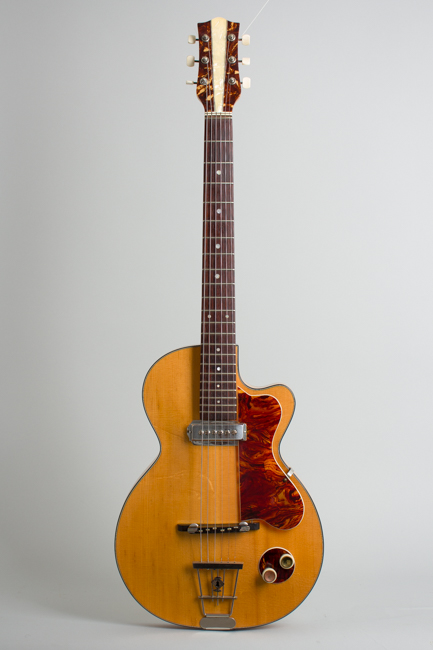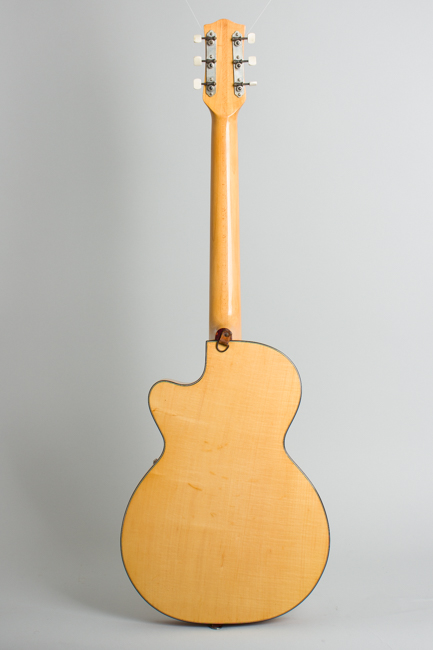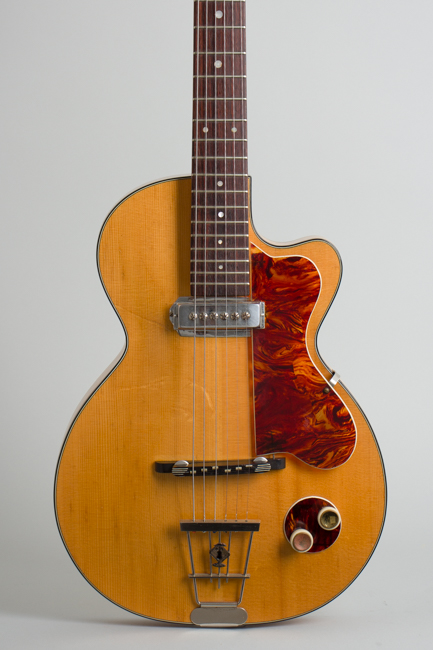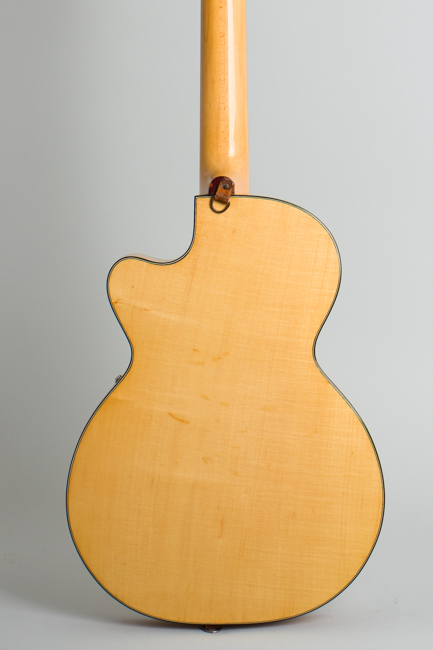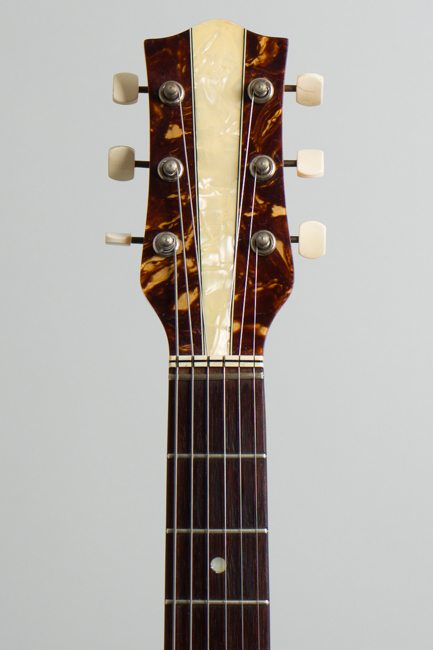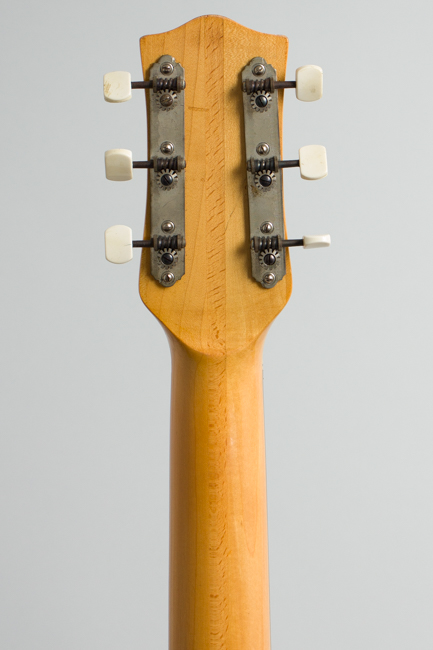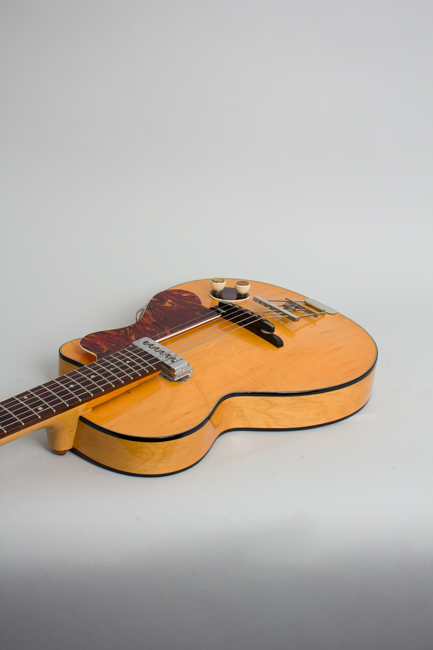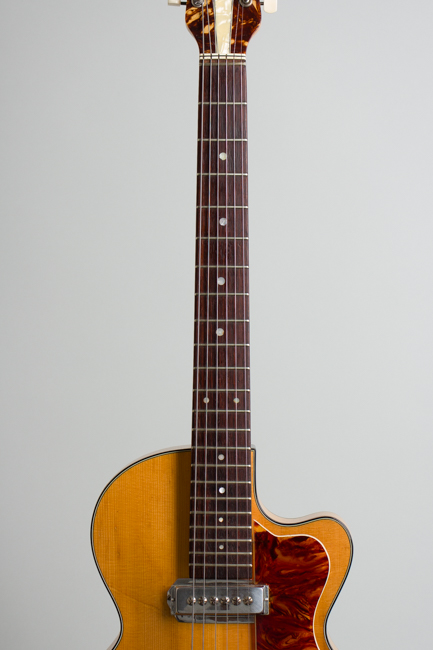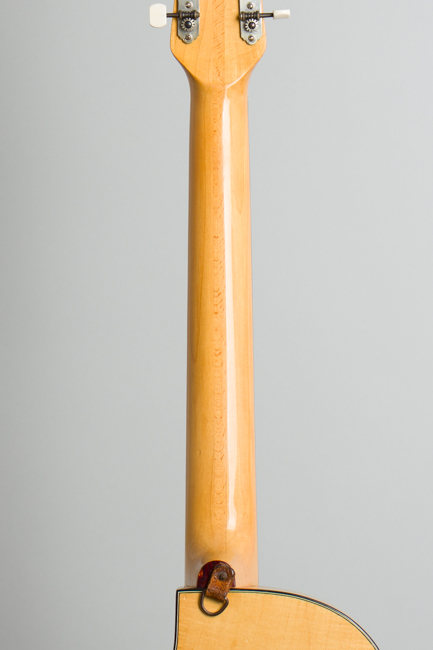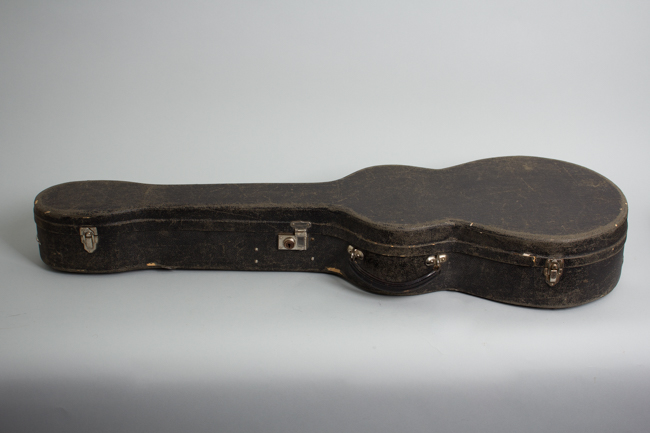Hofner Model 125 (Club 40) Arch Top Hollow Body Electric Guitar (1955-7)
Hofner Model 125 (Club 40) Model Arch Top Hollow Body Electric Guitar (1955-7), made in Bubenreuth, Germany, natural lacquer finish, laminated maple body, spruce top; laminated maple neck with rosewood fingerboard, original black hard shell case.
The Hofner Club 40 is a classic beat group guitar, a mainstay of the Hamburg, Liverpool and London music scenes in the late 1950s and early '60s. This rare guitar is its earliest iteration, originally called the Model 125 before the familiar "Club" designation was added by Selmer in London. It was introduced in 1954-5 and this early example mounts a metal-covered pickup supplied by Fuma, another German manufacturer. This is the second variation with the Fuma pickup wired to the oval control panel with two "teacup" knobs Hofner would use for a few more years. Hofner developed their own wood-covered bar pickups around this time, and these eventually became the standard fitting.
In general this single pickup, small hollow body electric was the most affordable version of one of the German Hofner company's more original creations, the Club series electrics. This line of small-body slimline arch-tops with no sound holes were popular in Europe and especially the UK in the late '50s and early '60s before American guitars were widely available. The Clubs were some of the handiest guitars available to the UK (and European) market, but were completely unknown in the US at the time.
This example has features specific to 1955-7, most notably the metal-covered Fuma Type 507 nickel-plated single coil pickup with adjustable poles. The earliest model 125s had radio-style knobs mounted directly to the top, but this one has metal-capped Hofner knobs set into a round tortoise celluloid plate. The body is made of laminated maple with a flat back and a carved spruce top, another early feature replaced with laminate spruce. It has a nicely ambered natural finish overall, with triple dark binding on the body and a red tortoise celluloid pickguard. The trapeze tailpiece is a standard Hofner part bearing the "KH" (Karl Hofner) logo crest in the center. The bridge is the familiar Hofner adjustable ebony piece slotted on the top with short pieces of fret wire serving as semi-intonatable saddles.
The chunky-feeling neck is a 3-piece maple laminate with a thick unbound dot-inlaid rosewood fingerboard. The three-ply plastic nut sits above a zero fret, a standard Hofner feature. The early-style headstock veneer is made up of three sections of contrasting plastic, a pearloid center bracketed by tortoise celluloid panels. This was replaced in 1957 with a plainer dark Hofner-logo'd piece. The original tuners are plain openback strips with oblong creme plastic buttons.
The Club models were among the most popular Beat-group guitars in early 1960s Liverpool and Hamburg; all three Beatle guitarists played later versions of the single-pickup Club 40 model during the early stages of the group. John McNally of the Searchers played a top-line Club 60 on all the group's early recordings, which remain an excellent demonstration of this guitar's capacity as a propulsive rhythm machine.
This original Model 125 is a very rare guitar in the US; they were never imported or sold here when new. Over the years many of these beautifully made but rather fragile guitars have been lost to time and tide; this is a super primal example of this cool Hofner classic, really as nice as we have seen on these shores in excellent playing condition.
Overall length is 38 in. (96.5 cm.), 13 in. (33 cm.) wide at lower bout, and 1 3/4 in. (4.4 cm.) in depth, measured at side of rim. Scale length is 24 1/4 in. (616 mm.). Width of nut is 1 9/16 in. (40 mm.).
This is a very nice all-original example of this extremely rare 70 year old guitar showing some light typical wear but no visible structural damage or alterations. The all-original natural finish has scuffs, dings and scratches overall, with a few deeper scratches and dents mostly to the soft spruce top. The neck has almost certainly been re-set and the seam in the heel re-sealed, a clean job but with one visible glue drip on the treble side of the heel. This is ubiquitous with older Hofners and better done than many in this case.
All hardware appears original and complete, including the quirky original thin leather "Dog clip" strap with leather fasteners screwed to the instrument. One of the knobs has been cracked and glued back together and the cap shows notable corrosion. The often-missing original pickguard has some scuffing wear to the top surface but it fully intact.
Overall this guitar is an excellent condition example of a Club of this vintage; these are rather fragile instruments and do not stand a lot of abuse! The original frets show hardly any wear, the neck is not absolutely straight but closer than many and fully playable, within the limits of these early Hofners. It offers the typical bouncy feel and punchy sound and includes the original German-made pasteboard HSC with the original leather strap in the pocket. Overall Excellent Condition.
The Hofner Club 40 is a classic beat group guitar, a mainstay of the Hamburg, Liverpool and London music scenes in the late 1950s and early '60s. This rare guitar is its earliest iteration, originally called the Model 125 before the familiar "Club" designation was added by Selmer in London. It was introduced in 1954-5 and this early example mounts a metal-covered pickup supplied by Fuma, another German manufacturer. This is the second variation with the Fuma pickup wired to the oval control panel with two "teacup" knobs Hofner would use for a few more years. Hofner developed their own wood-covered bar pickups around this time, and these eventually became the standard fitting.
In general this single pickup, small hollow body electric was the most affordable version of one of the German Hofner company's more original creations, the Club series electrics. This line of small-body slimline arch-tops with no sound holes were popular in Europe and especially the UK in the late '50s and early '60s before American guitars were widely available. The Clubs were some of the handiest guitars available to the UK (and European) market, but were completely unknown in the US at the time.
This example has features specific to 1955-7, most notably the metal-covered Fuma Type 507 nickel-plated single coil pickup with adjustable poles. The earliest model 125s had radio-style knobs mounted directly to the top, but this one has metal-capped Hofner knobs set into a round tortoise celluloid plate. The body is made of laminated maple with a flat back and a carved spruce top, another early feature replaced with laminate spruce. It has a nicely ambered natural finish overall, with triple dark binding on the body and a red tortoise celluloid pickguard. The trapeze tailpiece is a standard Hofner part bearing the "KH" (Karl Hofner) logo crest in the center. The bridge is the familiar Hofner adjustable ebony piece slotted on the top with short pieces of fret wire serving as semi-intonatable saddles.
The chunky-feeling neck is a 3-piece maple laminate with a thick unbound dot-inlaid rosewood fingerboard. The three-ply plastic nut sits above a zero fret, a standard Hofner feature. The early-style headstock veneer is made up of three sections of contrasting plastic, a pearloid center bracketed by tortoise celluloid panels. This was replaced in 1957 with a plainer dark Hofner-logo'd piece. The original tuners are plain openback strips with oblong creme plastic buttons.
The Club models were among the most popular Beat-group guitars in early 1960s Liverpool and Hamburg; all three Beatle guitarists played later versions of the single-pickup Club 40 model during the early stages of the group. John McNally of the Searchers played a top-line Club 60 on all the group's early recordings, which remain an excellent demonstration of this guitar's capacity as a propulsive rhythm machine.
This original Model 125 is a very rare guitar in the US; they were never imported or sold here when new. Over the years many of these beautifully made but rather fragile guitars have been lost to time and tide; this is a super primal example of this cool Hofner classic, really as nice as we have seen on these shores in excellent playing condition.
Overall length is 38 in. (96.5 cm.), 13 in. (33 cm.) wide at lower bout, and 1 3/4 in. (4.4 cm.) in depth, measured at side of rim. Scale length is 24 1/4 in. (616 mm.). Width of nut is 1 9/16 in. (40 mm.).
This is a very nice all-original example of this extremely rare 70 year old guitar showing some light typical wear but no visible structural damage or alterations. The all-original natural finish has scuffs, dings and scratches overall, with a few deeper scratches and dents mostly to the soft spruce top. The neck has almost certainly been re-set and the seam in the heel re-sealed, a clean job but with one visible glue drip on the treble side of the heel. This is ubiquitous with older Hofners and better done than many in this case.
All hardware appears original and complete, including the quirky original thin leather "Dog clip" strap with leather fasteners screwed to the instrument. One of the knobs has been cracked and glued back together and the cap shows notable corrosion. The often-missing original pickguard has some scuffing wear to the top surface but it fully intact.
Overall this guitar is an excellent condition example of a Club of this vintage; these are rather fragile instruments and do not stand a lot of abuse! The original frets show hardly any wear, the neck is not absolutely straight but closer than many and fully playable, within the limits of these early Hofners. It offers the typical bouncy feel and punchy sound and includes the original German-made pasteboard HSC with the original leather strap in the pocket. Overall Excellent Condition.
